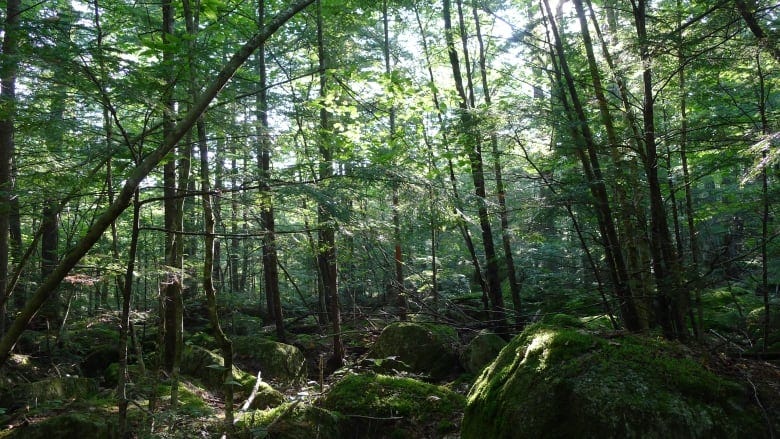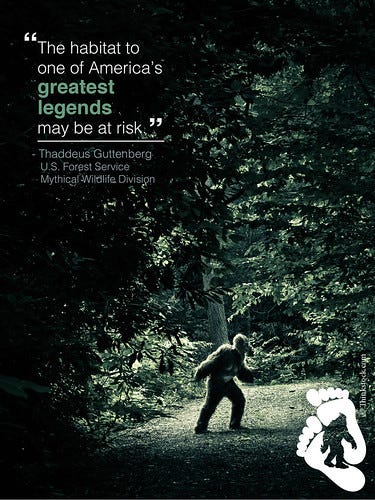Bigfoot: The Enigma of the Elusive Cryptid
Written on
Bigfoot, often considered the most plausible of mythical beings, raises a compelling question: if it exists, why has no one found definitive evidence? A new theory may provide insights into this enduring mystery.
To substantiate the claim that “Bigfoot is real,” we must adopt a scientific approach, shedding our mythological biases. Are there large creatures capable of evading human detection? Are there parallels in nature? Can the environment sustain a contemporary population of such beings? If the answers lean towards affirmation, we must devise methods for investigation.

The Art of Concealment
In 1972, in Guam, two men, Jesus Duenas and Manuel De Gracia, trekked along the Talofofo River when they heard rustling in the grass behind them. Armed and alert, they turned around too late to see their attacker, but they managed to subdue him and bring him to the police, who discovered he was Shoichi Yokoi, a soldier who had evaded capture since World War II.
Yokoi spent 28 years in the wilderness, unaware that the war had ended, fearing he would face execution if found. He meticulously avoided contact with people, living in a secluded underground hut and only emerging to catch eels. Even in death, he sought to conceal himself, stating, “I cannot expose my corpse to the enemy. I must go back to my hole to die.”
For decades, Yokoi was untraceable.
This illustrates that a large, bipedal mammal could exist undetected amidst encroaching civilization. To remain hidden, Bigfoot would require considerable ingenuity and intelligence, necessitating meticulous daily planning.
However, Guam's dense jungles differ significantly from the mountainous terrains of Oregon and Washington, where modern society thrives. Is it truly feasible for a creature to live as Yokoi did within the United States?
At just 20 years old, Christopher Knight vanished into the woods, seeking solitude. His survival strategy shifted from foraging to stealing from cabins. He observed the human inhabitants from afar, learning their routines to evade detection.

Knight became nocturnal, setting up camp in an area avoided by hikers, expertly erasing his tracks. Although suspicions arose among locals, no one could provide concrete evidence of his presence.
He lived without detection... for 27 years.
What If Bigfoot Is Like Us?
The scientific community generally resists attributing human-like traits to Bigfoot. Historically, the notion that even apes possess advanced intelligence has been met with skepticism. The prevailing image of Sasquatch is that of a simple, lumbering creature, devoid of cunning.
This skepticism is often rooted in a lack of evidence. Some theorize it’s a government cover-up, while others argue there’s nothing to uncover. However, the reality might be simpler: like Yokoi and Knight, Bigfoot might simply prefer to stay hidden.
Picture Bigfoot lurking in the shadows of the forest, evading human sight, establishing camps in remote areas, and erasing all traces of its existence. Unlike Knight, Bigfoot's advantage lies in its ability to thrive in nature, remaining elusive in its solitude.
The Plausibility of Bigfoot as a Mythical Creature
Most legendary beings, be they magical or mystical, defy the laws of nature. Griffins and mermaids blend species, while werewolves transform under the moonlight. In contrast, Bigfoot operates within the confines of biological reality—tall but not overly so, incapable of flight or supernatural feats.
Described by eyewitnesses, Bigfoot is said to have a foul odor and leaves footprints, displaying behavior typical of an animal rather than a myth. While often dismissed as a mere legend, the characteristics of Bigfoot resonate with the ordinary.
Assessing Bigfoot's Habitat

The US Department of Agriculture once playfully noted the dwindling habitat available for Sasquatch, highlighting real figures: approximately 6,000 acres of land vanish daily. While the actual population of this mythical being remains uncertain, the question arises—how long until they are gone?
To ascertain Bigfoot's existence, we must understand how many could thrive in their supposed environment, known as the Minimum Viable Population (MVP). Conservationists often refer to the 50/500 rule—50 individuals to prevent inbreeding and 500 to avoid extinction. Given rapid environmental changes, Bigfoot might require at least 5,000 adults to sustain a population. Recent data indicates a decline in sightings, suggesting that if Sasquatch exists, they may vanish before we can prove it.
A lighthearted study from the University of Illinois suggested that Bigfoot occupies a niche similar to that of black bears. With an estimated 300,000 black bears in the U.S., they are frequently seen and tracked. So, why is Bigfoot elusive?
Wolves might offer a more fitting comparison. Rarely spotted, their numbers dwindle outside Minnesota, with only one sighting reported in Colorado since 2015, while 11 Bigfoot sightings occurred in the same timeframe.
If one were to dismiss wolves as mythical, the data would support such a notion, even as they share the same habitat as black bears.
In pre-Columbian times, North America was home to about 3.8 million people, primarily along rivers and coasts. Humans typically avoid mountainous terrains, opting for fertile land with access to water. Regions of steep terrain were largely uninhabited, consistent with Bigfoot sightings.
Evidence, Please
Even if Bigfoot could survive in isolated areas, we still require tangible proof. Where are the bones, teeth, or any remains?
The creature's elusiveness constitutes the most significant argument against its existence. Despite suburban expansion and increased tourism, Bigfoot remains unseen. How can this be explained?
It cannot. Sightings of Sasquatch abound, with countless videos showcasing shadowy figures or brief glimpses. Recent footage, recorded with advanced cameras, appears convincingly authentic.
Parents capture their children at play, only to later spot an unusual figure in the background. Hunters document their encounters, hearts racing. Women panic as their dogs chase something unseen.
Throughout these recordings, the behavior of these enigmatic beings remains consistent. A Bigfoot mother cautiously gathers her young to flee; a figure pauses mid-step, glancing toward the camera before vanishing. In nearly all instances, the creature seems unaware of its observer, hiding or retreating.
If footage existed of Yokoi or Knight, would it not resemble these encounters?
For a legendary being, evidence of Bigfoot is abundant. Numerous sightings, audio recordings, structures, and footprints exist alongside accounts from adventurers, hunters, and everyday individuals who risk ridicule by sharing their experiences.
> “We are to admit no more causes of natural things such as are both true and sufficient to explain their appearances.” — Isaac Newton, *Principia Mathematica*
Confronting the Myth-Bias
Bigfoot suffers from a myth-bias. Positioned alongside fairies and mermaids, scientific inquiry often overlooks it.
To illustrate this bias, consider discussing a rare toad from Sri Lanka. With muddy footprints, croaking sounds, and numerous blurry videos of toads, would the scientific community dismiss its existence simply because no trained biologist has identified it? Most likely not; researchers would compete for funding to explore its habitat.
In contrast, Bigfoot's evidence is frequently dismissed based on the assumption that it cannot exist. Esteemed publications like Scientific American and National Geographic are not immune to this bias, contradicting their foundational principles. This is a unique phenomenon in scientific discourse.
Skeptics argue that Bigfoot’s human-like qualities render it implausible. Critics of famous footage argue the creature’s gait resembles humans more than apes. Even when the Sierra Sounds fall within human vocal ranges, skeptics dismiss these abilities in non-human primates. This perspective leads many to view human-like traits as indicative of a hoax.
However, scientific history presents evidence of similar creatures existing in the past. Gigantopithecus blacki was initially identified from just two teeth, Australopithecus from a skull fragment, and Homo erectus from limited remains. The existence of archaic humans is a possibility as recent as 11,000 years ago. It may be more accurate to assert that Bigfoot is extinct rather than never having existed.
In fact, one species alive today bears a striking resemblance to Bigfoot.
That species is us.
If Bigfoot were to walk on its knuckles, it might be more readily accepted. Animals that pose no threat to our sense of superiority, like apes, are readily accepted; Bigfoot's human-like traits challenge that view.
While we can refute claims against Bigfoot's existence, we cannot definitively prove it without systematic scientific inquiry, evidence collection, and ideally, a live specimen.
First, we must entertain the hypothesis that Bigfoot is real. By setting aside our myth-bias, we may uncover new possibilities.
The urgency is palpable. With climate change threatening countless species, we may lose Sasquatch before we can investigate further. We could be on the brink of losing a potential link to our evolutionary past. If there’s something worth protecting, it’s our connection to nature.
Initiating the Study
A birdwatcher scans the treetops of Umatilla National Forest, hoping to catch a glimpse of the elusive Marbled Murrelet. Instead, she encounters a pair of wide, curious eyes staring back at her. As the creature stands on two legs, it quickly retreats into the underbrush, glancing back to ensure it isn’t followed. The moment passes too quickly for a photograph, but she swiftly dials a hotline.
In an instant, the hotline’s system captures her GPS coordinates, notifying a NASA satellite. The satellite scans the area, detecting a large figure moving away from the caller's position. Local authorities are alerted and dispatched to the location. What will they find?